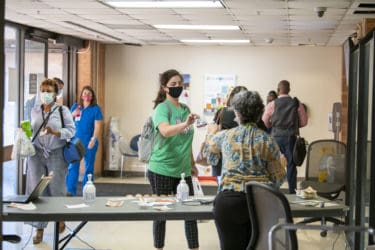Study by UAMS Researchers Finds Low Risk of COVID-19 Infection from Hospital
| People who had recently been in the hospital were 24 times less likely to develop a COVID-19 infection than the general population, University of Arkansas for Medical Sciences (UAMS) researchers found in a study that used data from 45 hospitals.
The study focused on people who had been in the hospital for conditions not related to COVID-19. Among the 101,533 patients, only 44 (0.043%) tested positive for COVID-19 within 14 days of discharge from the hospital. By comparison, the percentage of positive COVID-19 patients among the total U.S. population is 1.035%.
Krishna Nalleballe, M.D., is the lead author on the study and stroke neurologist and assistant professor in the Department of Neurology in the UAMS College of Medicine. He said hospitals across the nation have reported fewer people visiting the hospital and emergency rooms, even for illnesses like strokes and heart attacks where life-saving care is time-sensitive.

Entrance screening for all employees and patients is one of several COVID-19 infection prevention protocols in place at UAMS.Bryan Clifton
“We suspect these trends are related to patient fears about contracting COVID-19 while in the hospital, so we wanted to take a closer look,” Nalleballe said. “The results, which suggest low rates of infection, should be reassuring and encourage patients to seek timely treatment of health care problems during the COVID-19 pandemic to avoid unnecessary complications and impacts on quality of life.”
Many hospitals, including UAMS, have enacted targeted policies to reduce the spread of COVID-19, including personal protective equipment for medical staff, universal masking for staff and patients, limiting or restricting visitors, and heightened cleaning protocols and ventilation standards.
“These results suggest that such precautionary measures are working and creating an environment of relatively low risk in the hospital setting,” Nalleballe said.
The study has been accepted for publication in Infection Control & Hospital Epidemiology, a peer-reviewed medical journal. Co-authors from UAMS include Sukanthi Kovvuru, M.D.; Poornachand Veerapaneni, M.D.; and Sanjeeva Reddy Onteddu, M.D., of the Department of Neurology and Suman Siddamreddy, M.D., of the Department of Internal Medicine. Bhaskar Roy of the Department of Neurology at the Yale School of Medicine is also a co-author.
Data for the study came from TriNetX, a global clinical research platform that collected anonymous patient data from 45 health care organizations in real time. It contains a large amount of data about COVID-19 patients and is being used by the U.S. Food and Drug Administration and Harvard Pilgrim Health Care Institute as researchers look for trends to pinpoint the best drugs and therapies for COVID-19 patients.
The study was supported by the UAMS Translational Research Institute (TRI), grant TL1 TR003109, through the National Center for Advancing Translational Sciences of the National Institutes of Health (NIH). The content is solely the responsibility of the authors and does not necessarily represent the official views of the NIH.
Stroke is the fifth leading cause of death in the United States and can lead to debilitating lingering effects. However, advances in stroke care mean patients with a particular type of stroke can receive lifesaving “clot-busting” drug therapies that dramatically improve quality of life. The patient must be diagnosed by a stroke specialist, and the drug must be administered within hours after the onset of symptoms.
Through the UAMS Health Institute for Digital Health & Innovation Stroke Program, UAMS partners with hospitals across the state to provide access to stroke specialists for diagnosis via a statewide videoconferencing consult service. The program was implemented in 2008 after years of Arkansas leading stroke deaths per capita nationwide. In 2018, Arkansas’ stroke death ranking had dropped to 10th in the nation.
In 2018, UAMS Medical Center became the first and only health care provider in Arkansas to be certified as a Comprehensive Stroke Center by The Joint Commission. The certification is the most demanding accreditation and is designed for those hospitals that have the specific abilities to receive and treat the most complex stroke cases.
The Joint Commission is an independent, nonprofit organization that evaluates and accredits more than 20,000 health care organizations in the United States.
This year, the UAMS stroke program also was recognized with the Target Stroke Honor Roll for compliance with standards for quick and timely treatment of stroke for six consecutive years.
UAMS is the state’s only health sciences university, with colleges of Medicine, Nursing, Pharmacy, Health Professions and Public Health; a graduate school; a hospital; a main campus in Little Rock; a Northwest Arkansas regional campus in Fayetteville; a statewide network of regional campuses; and eight institutes: the Winthrop P. Rockefeller Cancer Institute, Jackson T. Stephens Spine & Neurosciences Institute, Harvey & Bernice Jones Eye Institute, Psychiatric Research Institute, Donald W. Reynolds Institute on Aging, Translational Research Institute, Institute for Digital Health & Innovation and the Institute for Community Health Innovation. UAMS includes UAMS Health, a statewide health system that encompasses all of UAMS’ clinical enterprise. UAMS is the only adult Level 1 trauma center in the state. UAMS has 3,485 students, 915 medical residents and fellows, and seven dental residents. It is the state’s largest public employer with more than 11,000 employees, including 1,200 physicians who provide care to patients at UAMS, its regional campuses, Arkansas Children’s, the VA Medical Center and Baptist Health. Visit www.uams.edu or uamshealth.com. Find us on Facebook, X (formerly Twitter), YouTube or Instagram.###
